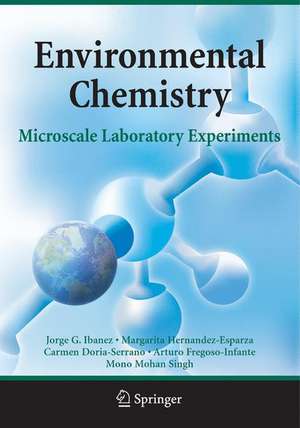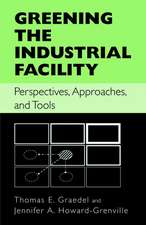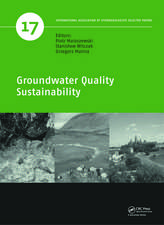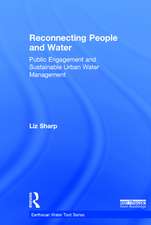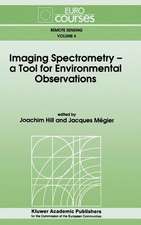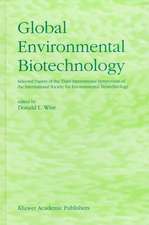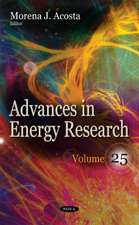Environmental Chemistry: Microscale Laboratory Experiments
Autor Jorge G. Ibanez, Margarita Hernandez-Esparza, Carmen Doria-Serrano, Arturo Fregoso-Infante, Mono Mohan Singhen Limba Engleză Paperback – 18 noi 2007
This work fulfills an urgent need for an introductory text in environmental chemistry combining theory and practice, and is a valuable tool for preparing the next generation of environmental scientists.
Toate formatele și edițiile
| Toate formatele și edițiile | Preț | Express |
|---|---|---|
| Paperback (2) | 371.26 lei 38-45 zile | |
| Springer – 18 noi 2007 | 371.26 lei 38-45 zile | |
| Springer – 15 oct 2010 | 496.23 lei 6-8 săpt. | |
| Hardback (1) | 652.49 lei 6-8 săpt. | |
| Springer – 6 iun 2007 | 652.49 lei 6-8 săpt. |
Preț: 371.26 lei
Nou
Puncte Express: 557
Preț estimativ în valută:
71.04€ • 74.17$ • 58.79£
71.04€ • 74.17$ • 58.79£
Carte tipărită la comandă
Livrare economică 31 martie-07 aprilie
Preluare comenzi: 021 569.72.76
Specificații
ISBN-13: 9780387494920
ISBN-10: 0387494928
Pagini: 238
Ilustrații: XII, 238 p.
Dimensiuni: 170 x 242 x 11 mm
Greutate: 0.45 kg
Ediția:2008
Editura: Springer
Colecția Springer
Locul publicării:New York, NY, United States
ISBN-10: 0387494928
Pagini: 238
Ilustrații: XII, 238 p.
Dimensiuni: 170 x 242 x 11 mm
Greutate: 0.45 kg
Ediția:2008
Editura: Springer
Colecția Springer
Locul publicării:New York, NY, United States
Public țintă
Professional/practitionerCuprins
Experiments.- Water Characterization.- Dissolved Oxygen in Water.- Alkalinity and Buffering Capacity of Water.- Aqueous Carbonate Equilibria and Water Corrosiveness.- The Point of Zero Charge of Oxides.- Experimental Transitions in E vs pH (or Pourbaix) Diagrams.- Air Oxidation of Metal Ions.- Photoassisted Reduction of Metal Complexes.- Anionic Detergents and o-Phosphates in Water.- Halogenated Hydrocarbons and the Ozone Layer Depletion.- Acid Mine (or Acid Rock) Drainage.- Electrochemical Treatment of Gas Pollutants.- Electrochemical Treatment of Liquid Wastes.- Electrochemical Treatment of Polluted Soils.- Removal of Nitric Oxide by Complex Formation.- Photocatalytic Remediation of Pollutants.- Chemical Mineralization of Pollutants Through the Fenton Reaction.- Production and Analysis of Chloramines.- Production and Analysis of Chlorine Dioxide.- Metal Ion Recovery By Cementation.- Green Chemistry: The Recovery and Reuse of Sulfur Dioxide (Obendrauf’s Method).- Microorganisms in Soil, Water, and Air.- Toxicity Assay Using Bacterial Growth.- Wastewater Disinfection.
Textul de pe ultima copertă
Environmental Chemistry: Fundamentals, by Jorge Ibanez et al., is an exceptionally useful and well organized book. After reviewing basic chemical concepts, Environmental Chemistry: Fundamentals quickly progresses to more advanced and contemporary applications including ozone depletion, physiochemical and biological treatment of pollutants, and green chemistry.
The chemistry of processes of the atmosphere, lithosphere and hydrosphere are covered in detail and the effects of pollutants on each of these chemical processes are extensively considered, as are their effects on the biosphere.
The book also has an experimental companion, Environmental Chemistry: Microscale Laboratory Experiments, which includes an array of environmental chemistry experiments that can be readily performed at the microscale level. Ideas for additional open-ended projects are provided for all experiments, and they impart a thorough introduction to environmental experimentation.
I strongly recommend Environmental Chemistry: Fundamentals and its experimental accompaniment, Environmental Chemistry: Microscale Laboratory Experiments.
Dr. Zvi Szafran
Vice President for Academic Affairs and Professor of Chemistry
Southern Polytechnic State University
Our Earth is a remarkable reaction vessel. It is of paramount importance that students grow in their understanding and awareness of the astounding effects that chemistry and biochemistry have on our environment…and why they are so significant to our present and future hopes as a civilization.
Environmental Chemistry: Microscale Laboratory Experiments, intended to complement lessons in the companion textbook Environmental Chemistry: Fundamentals, covers the chemical and biochemical processes that take place in air, water, soil, and living systems. The corresponding experiments range from thecharacterization of aqueous media to pollutant-treatment schemes. For increased safety, as well as for reduced costs, wastes, and environmental damage, the experiments are presented at the microscale level. Pre- and post-laboratory exercises and open-ended projects accompany each experiment, to develop problem-solving skills and initiative among students.
The chemistry of processes of the atmosphere, lithosphere and hydrosphere are covered in detail and the effects of pollutants on each of these chemical processes are extensively considered, as are their effects on the biosphere.
The book also has an experimental companion, Environmental Chemistry: Microscale Laboratory Experiments, which includes an array of environmental chemistry experiments that can be readily performed at the microscale level. Ideas for additional open-ended projects are provided for all experiments, and they impart a thorough introduction to environmental experimentation.
I strongly recommend Environmental Chemistry: Fundamentals and its experimental accompaniment, Environmental Chemistry: Microscale Laboratory Experiments.
Dr. Zvi Szafran
Vice President for Academic Affairs and Professor of Chemistry
Southern Polytechnic State University
Our Earth is a remarkable reaction vessel. It is of paramount importance that students grow in their understanding and awareness of the astounding effects that chemistry and biochemistry have on our environment…and why they are so significant to our present and future hopes as a civilization.
Environmental Chemistry: Microscale Laboratory Experiments, intended to complement lessons in the companion textbook Environmental Chemistry: Fundamentals, covers the chemical and biochemical processes that take place in air, water, soil, and living systems. The corresponding experiments range from thecharacterization of aqueous media to pollutant-treatment schemes. For increased safety, as well as for reduced costs, wastes, and environmental damage, the experiments are presented at the microscale level. Pre- and post-laboratory exercises and open-ended projects accompany each experiment, to develop problem-solving skills and initiative among students.
Caracteristici
Holistic approach gives students firm theoretical and experimental grounding in environmental chemistry Perfect for undergraduate environmental chemistry courses, which are becoming more widespread Pre- and post-laboratory exercises to develop problem-solving skills Innovative sections on waste minimization, environmental legislation, biochemical processes, remediation procedures, and environmental economics Provides a comprehensive and unique microscale approach to teaching Environmental Chemistry courses that is intended to be completed in one semester, unlike competing textbooks Request lecturer material: sn.pub/lecturer-material
